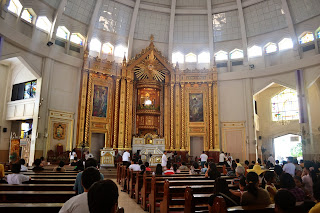Our Lady of Peace and Good Voyage (Spanish: Nuestra Señora de la Paz y Buen Viaje), also known as the Virgin of Antipolo (Filipino: Birhen ng Antipolo), is a 17th-century Roman Catholic brown wooden statue of the Blessed Virgin Mary venerated by Roman Catholics in the Philippines. The statue depicting the Immaculate Conception of Mary, is enshrined at the Antipolo Cathedral in the city of Antipolo in Rizal province.
On March 25, 1626, the galleon trading ship El Almirante left Acapulco, Mexico. On board was the newly appointed Governor of the Philippines Don Juan Niño de Tabora who brought with him the statue from Mexico. The new governor arrived on July 18, 1626. The statue was first taken to Saint Ignatius Church (Spanish: San Ignacio Church), the Jesuit church in Intramuros. When Governor Tabora died in 1632, the statue was donated to the Jesuits for enshrinement in the church of Antipolo in barangay Santa Cruz. During the construction of the church, the statue would allegedly disappear and later found on top of a Tipolo (breadfruit) tree (artocarpus incisa).
In 1639, the Chinese rose in revolt burning the Antipolo town and church. In fear that the statue would be destroyed, Governor Sebastian Hurtado de Corcuera ordered the statue be transferred back to Cavite where it was temporarily venerated.
Don Sebastian ordered the statue removed in 1648, when it was transferred from its Cavite shrine and was shipped back to Mexico aboard the San Luis galleon. At the time, having a statue of a saint on the ship served as a patroness or protector of the Acapulco trade.
The statue crisscrossed the Pacific Ocean on Manila-Acapulco Galleon trade ships six times from 1648 to 1748 aboard the: San Luis — (1648–1649) Encarnacion — (1650) San Diego — (1651–1653)
San Francisco Javier — (1659–1662) Nuestra Señora del Pilar — (1663) San Jose — (1746–1748)
The cathedral's façade from the southwest
The cathedral's façade from the northwest
High altar, with the image of Our Lady of Peace and Good Voyage enshrined behind glass.Bas-relief in painted wood depicting the first arrival of Our Lady of Peace and Good Voyage in the Philippines
Cathedra of the Bishop






























